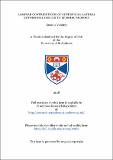Files in this item
Laminar contributions of superficial lateral entorhinal cortex to episodic memory
Item metadata
| dc.contributor.advisor | Ainge, James Alexander | |
| dc.contributor.author | Vandrey, Brianna | |
| dc.coverage.spatial | xi, 179 p. | en_US |
| dc.date.accessioned | 2019-06-27T13:55:32Z | |
| dc.date.available | 2019-06-27T13:55:32Z | |
| dc.date.issued | 2018-07 | |
| dc.identifier.uri | https://hdl.handle.net/10023/17987 | |
| dc.description.abstract | Episodic memory relies on the hippocampus and its surrounding cortical network. The superficial layers of the entorhinal cortex provide substantial input to the hippocampus within this network. Recent evidence suggests that the lateral entorhinal cortex (LEC) is critical for binding together features of an episode, and single neurons in the LEC encode spatial information about local cues in the environment. However, the relationship between entorhinal-hippocampal circuit components and cognition is unclear. Therefore, the experiments presented in this thesis investigated the functional contributions of projections to the hippocampus from the superficial LEC (layers 2/3; L2/3) to associative memory processes. First, I examined whether input from entorhinal cortex influences the activity of place cells in the CA1 region of the hippocampus. In an environment which contained objects, place cells which receive direct input from LEC L3 demonstrated a higher degree of spatial tuning than place cells which receive input from MEC L3, and exhibited firing patterns which were precisely tied to current and previous object locations. However, further elucidation of this finding was precluded by the lack of a tool which permits the selective manipulation the superficial LEC layers. Therefore, a second set of experiments investigated the arrangement of projecting neurons in LEC L2 and identified a molecular tool, the Sim1:Cre mouse, which permits the precise manipulation of excitatory neurons in LEC L2 which are positive for the protein reelin and project to the dentate gyrus. A final experiment selectively suppressed the output from these neurons in a cohort of Sim1:Cre mice and examined performance on a series of object-based recognition memory tasks. Indeed, inactivation of this pathway resulted in profound impairment on an episodic memory task and mildly impaired novel object recognition. Overall, these data suggest that projections from the superficial LEC to the hippocampus make critical contributions to associative memory processes. | en |
| dc.language.iso | en | en_US |
| dc.publisher | University of St Andrews | |
| dc.subject.lcc | BF378.E65V2 | |
| dc.title | Laminar contributions of superficial lateral entorhinal cortex to episodic memory | en_US |
| dc.type | Thesis | en_US |
| dc.type.qualificationlevel | Doctoral | en_US |
| dc.type.qualificationname | PhD Doctor of Philosophy | en_US |
| dc.publisher.institution | The University of St Andrews | en_US |
This item appears in the following Collection(s)
Items in the St Andrews Research Repository are protected by copyright, with all rights reserved, unless otherwise indicated.

